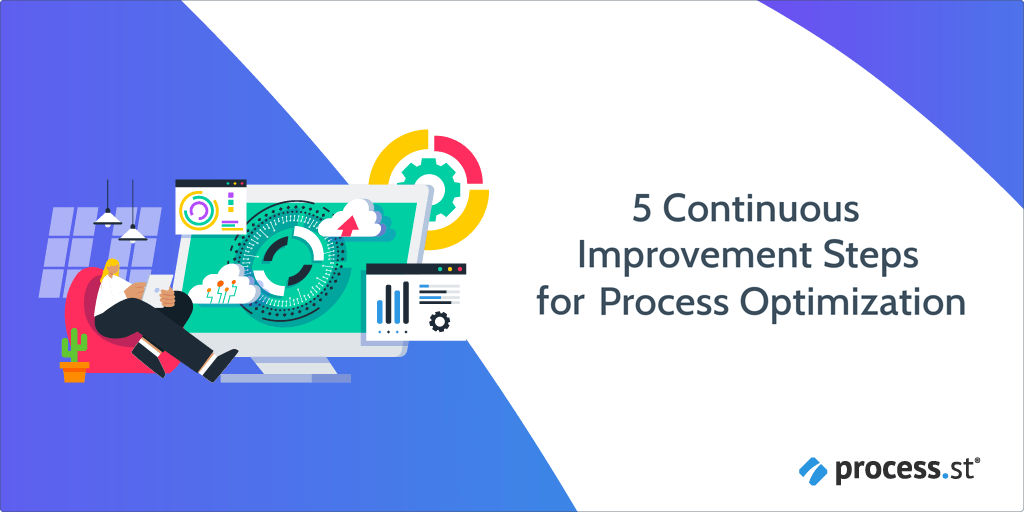
Continuous improvement without data collection is like driving cross country without signs or a map.
Data collection is vital to making improvements because without it there’s no real proof of any problem existing to begin with.
Why are you making improvements? Is it really a problem, or are you just distorted by frustration in the moment?
Yes, your frustration can give you clues as to what the root problem is, but relying on your feelings alone won’t give you accurate results in the long run.
That’s where data collection can help. Our Analytics feature can be used to paint an objective, unbiased picture of the current state of any given process and help highlight potential areas that could be improved upon.
So, let’s start by walking through our 5 continuous improvement steps for process optimization:
- Step 1: Identify the process to be improved
- Step 2: Assess efficacy & determine improvements
- Step 3: Implement process improvements
- Step 4: Test & track the updated process
- Step 5: Optimize the process with automation
Step 1: Identify the process to be improved
No process is perfect, but there are some that may be consistently causing you problems. That’s where you should start.
Note down the process most often wasting you and your team’s time and resources.
Then you’ll need to fully understand that process by answering the following questions:
- What’s the goal of the process?
- When does it start and end?
- What are the individual activities within the process?
- What departments/employees are involved?
- What information is carried over between steps?
The answers to these questions should help highlight all the elements that make up the process and clarify how to best approach optimizing it, starting with the specific goals this process is trying to reach.
Why you should document your processes
Before we move on, it’s important to ask yourself: How good is my process documentation?
You might know which processes need to be updated, but unless you have clear process documentation, continuous improvement is essentially impossible.
Continuous improvement only works if you can look at how something was working before, and compare it to the changes you’ve made. Having clearly written, accessible process documentation is the best way to facilitate continuous improvement.
Step 2: Assess efficacy & determine improvements
Now that you’ve got your process laid out, it’s time to assess its effectiveness and determine what improvements would be most optimal.
Start by recording the process’ strengths and weaknesses. This will help you to understand what’s working and what’s not, and where improvements could be made.
You may find that some of the tasks aren’t even necessary at all to meet the final goal. If you do run into this, consider consolidating some of these tasks, or even outright getting rid of them. It’s always better to have a process that’s concise and to the point rather than a process that may be overly complicated or confused in what it’s trying to achieve.
Step 3: Implement process improvements
If you have your process well documented, or better yet, you’re using a process management software, this task should be as easy as walking through your process step-by-step and making changes as you go.
A best practice for continuous improvement is to iterate new versions of a process whenever you make changes. This helps to prevent breaking things and makes it easier to track and compare data between different versions of a process, so you can accurately determine whether or not changes are truly improvements.
Another tip is to keep a simple log of any changes you make across each iteration, so it’s easier to share knowledge and ensure that everyone understands what changes were made, by who, and when.
Step 4: Test & track the updated process
Testing is important, foremost to make sure you haven’t broken anything. Run through the process, ideally in as close to real-world conditions as you can, and make sure that everything is working as expected.
Consider the final goal of the process – is this still being achieved?
Once you’ve established that the process improvements are functional, you can begin collecting data to assess the success of any changes.
Using Process Street Analytics
Being able to view the performance of your processes, your team, or clients is critical to understanding whether or not the changes you’ve made are actually more effective.
Information like task progress and active/completed workflow runs can help you locate bottlenecks and get a sense for how your team is responding to the changes.
Click here to learn more about Process Street‘s Analytics feature.
Step 5: Optimize the process with automation
At this point, you’re basically done. You’ve identified and implemented improvements, and you should be able to track those changes over time to assess success.
But if you want to go the extra mile and get the most out of your workflow management software, it’s time to consider which tasks (if any) could be automated.
First off – just to get it out of the way – if you’re using paper, you’ll almost certainly see efficiency gains if you switch over to digital process management.
For the rest of you, if you’re transferring data between apps (adding Dropbox files manually to Google Drive, for example), you should see if you can eliminate manual tasks with one of our native Automations.
It’s also worth checking out Zapier, Power Automate, and Make.com as there are a ton of automations available there.
What did you think of our 5 continuous improvement steps? Do you have any tips we may have left out? Let us know in the comments below!







Oliver Peterson
Oliver Peterson is a content writer for Process Street with an interest in systems and processes, attempting to use them as tools for taking apart problems and gaining insight into building robust, lasting solutions.